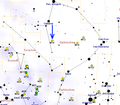Astronomy:Messier 14
| Messier 14 | |
|---|---|
 Globular cluster Messier 14 in Ophiuchus | |
| Observation data (J2000 epoch) | |
| Class | VIII[1] |
| Constellation | Ophiuchus |
| Right ascension | 17h 37m 36.15s[2] |
| Declination | –03° 14′ 45.3″[2] |
| Distance | 30.3 kly (9.3 kpc)[3] |
| Apparent magnitude (V) | 7.6[4] |
| Apparent dimensions (V) | 11.0′ |
| Physical characteristics | |
| Mass | 1.04×106[3] M☉ |
| Radius | 50 ly[5] |
| Metallicity | [math]\displaystyle{ \begin{smallmatrix}\left[\ce{Fe}/\ce{H}\right]\end{smallmatrix} }[/math] = –1.28[3] dex |
| Other designations | NGC 6402[2] |
Messier 14 (also known as M14 or NGC 6402) is a globular cluster of stars in the constellation Ophiuchus. It was discovered by Charles Messier in 1764.
At a distance of about 30,000 light-years, M14 contains several hundred thousand stars. At an apparent magnitude of +7.6 it can be easily observed with binoculars. Medium-sized telescopes will show some hint of the individual stars of which the brightest is of magnitude +14.
The total luminosity of M14 is in the order of 400,000 times that of the Sun corresponding to an absolute magnitude of -9.12. The shape of the cluster is decidedly elongated. M14 is about 100 light-years across.[6]
A total of 70 variable stars are known in M14, many of the W Virginis variety common in globular clusters. In 1938, a nova appeared, although this was not discovered until photographic plates from that time were studied in 1964. It is estimated that the nova reached a maximum brightness of magnitude +9.2, over five times brighter than the brightest 'normal' star in the cluster.
Slightly over 3° southwest of M14 lies the faint globular cluster NGC 6366.
Gallery
See also
References
- ↑ Shapley, Harlow; Sawyer, Helen B. (August 1927), "A Classification of Globular Clusters", Harvard College Observatory Bulletin 849 (849): 11–14, Bibcode: 1927BHarO.849...11S.
- ↑ 2.0 2.1 2.2 "NGC 6402". SIMBAD. Centre de données astronomiques de Strasbourg. http://simbad.u-strasbg.fr/simbad/sim-basic?Ident=NGC+6402.
- ↑ 3.0 3.1 3.2 Boyles, J. et al. (November 2011), "Young Radio Pulsars in Galactic Globular Clusters", The Astrophysical Journal 742 (1): 51, doi:10.1088/0004-637X/742/1/51, Bibcode: 2011ApJ...742...51B.
- ↑ "Messier 14". https://messier.seds.org/m/m014.html.
- ↑ distance × sin( diameter_angle / 2 ) = 50 ly radius
- ↑ "Messier 14 | Messier Objects" (in en-US). 31 March 2015. https://www.messier-objects.com/messier-14/.
External links
- SEDS Messier pages on M14
- M14, Galactic Globular Clusters Database page
- NASA Astronomy Picture of the Day: The Comet and the Star Cluster (11 April 2016) - one of the two being M14
- Messier 14 on WikiSky: DSS2, SDSS, GALEX, IRAS, Hydrogen α, X-Ray, Astrophoto, Sky Map, Articles and images
Coordinates: ![]() 17h 37m 36.15s, −03° 14′ 45.3″
17h 37m 36.15s, −03° 14′ 45.3″
 |




